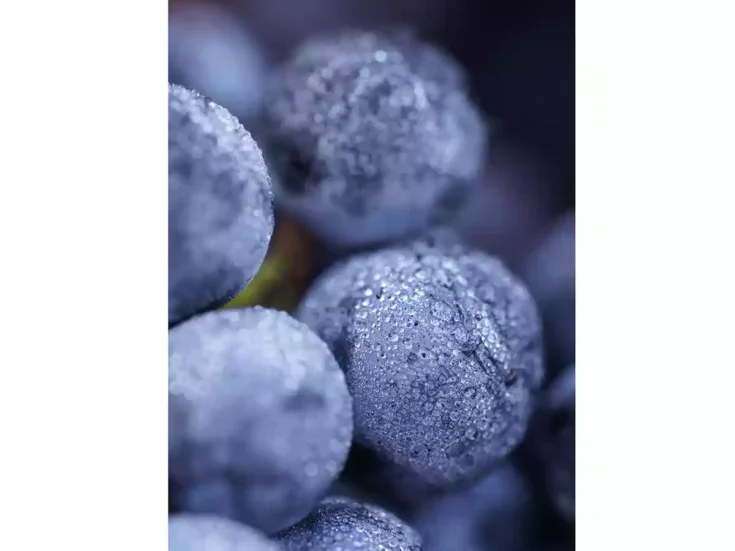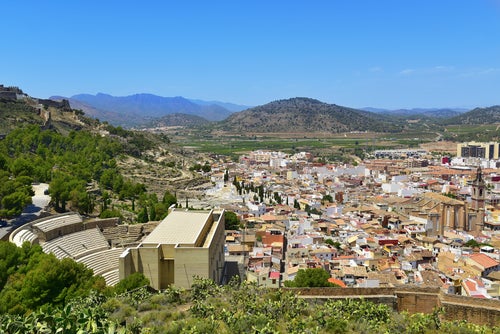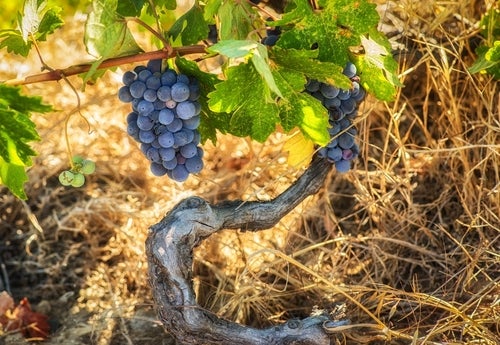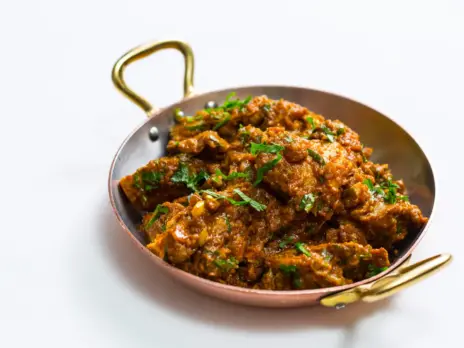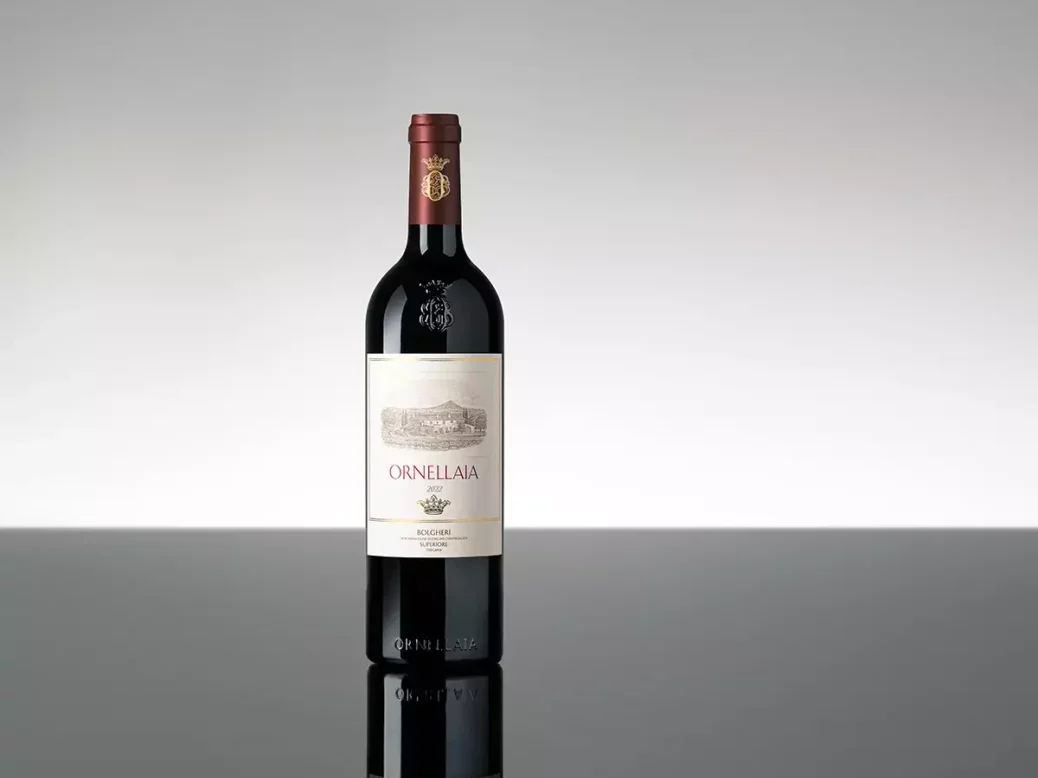
Sarah Marsh MW reports from the launch of 2022 Ornellaia.
La Determinazione was the one-word description chosen to represent the spirit of the 2022 vintage. “We had a clear vision of what we wanted to do,” explained Lamberto Frescobaldi, presenting the new vintage of Ornellaia at the winery in Bolgheri.
“Determinazione has a double meaning. It represents the determination of our technical team to bring home this wine, which is so expressive, and the determination of the Ornellaia vineyards. In a situation that was a bit extreme, the vines showed great resilience.”
Determination was also the brief for Cameroon artist Pascale Marthine Tayou, tasked with designing the label for the 2022 vintage, the 17th edition of the Vendemmia d’Artista project. One artistic label will be included in each case of six 750ml bottles of the vintage, and larger format bottles will be auctioned in March for charity.
The 2022 season was marked by a dry spring, followed by a lengthy period of drought from May, which continued for 75 days. “Within the past few years, we remember 2022 for the heat and the dryness,” mused Lamberto Frescobaldi. The vines, suffering with hydric stress throughout the season, from flowering to veraison, produced a small crop, 15% below average (Ornellaia does not declare how many bottles they produce), but welcome rain in August re-activated the ripening process. Hot and dry to start, the season became hotter and wetter, and the harvest began from August 25 with the Merlot. Happily, the rain stopped in September which, together with cool nights, provided good conditions to finish the maturation of the other red grape varieties. The last, Cabernet Sauvignon, was harvested on October 10.
Both the berries and bunches were small, giving a high skin-to-juice ratio, which is evident in the structure of the 2022. The concentrated juice produced a wine with 14.5% ABV, a pH of 3.58 and acidity higher than Frescobaldi expected.
The small berries needed gentle handing. “The team understood they had to extract in a specific way,” recalled Frescobaldi, although there were no finer details of how this was achieved, since the 2022 was made by Axel Heinz, who has since left Ornellaia. The blending, however, was managed by Marco Balsimelli, who joined Ornellaia as technical director in 2024. Coming from Bordeaux, he is no newcomer to blending, and at Ornellaia he has plenty of scope, because the blend comprises as many as 53 cuvées.
After selection in the vineyard and winery, the grapes go through an optical sorting machine, acquired for the 2016 vintage. Every grape variety and parcel is vinified individually, and the press wine for each is matured separately. So, there are up to 70 potential components. Balsimelli remarked that the press wines “bring depth to the blend, completing it on the palate and adding uniformity.” He continued, “We play with the parcels in the different vineyards, so we are less dependent on the whimsical character changes of every vintage.” Frescobaldi considers that the blending process “grasps the best expression of each vintage.”
“A very contemporary wine”
For the 2022, Balsimelli explains, “We used more Petit Verdot than the average of 5%, which brings a bright aromatic freshness to the nose, and we used a little less Merlot.” The blend is 55% Cabernet Sauvignon, 25% Merlot, 10% Cabernet Franc, and 10% Petit Verdot. “There was also 10% in 2017, which was also a hot and dry vintage.”
Indeed it was. Ornellaia presented the 2017 Vendemmia d’Artista in Florence in February 2020. I recall it well, for it was almost my last trip before lockdown, but mainly because the Argentine conceptual artist Tomàs Saracenoin, in a flourish of artistic temperament and amid increasingly awkward announcements regarding his appearance, failed to join the panel at the press conference. He slid in later, after most of the press had dispersed, to explain his interpretation of 2017 Solare. The label is a striking solar eclipse; a concept that invites us to focus on the relationship between the sun, as our most important source of energy, and the earth. It was a very sunny vintage.
I thought it would be interesting to compare these two sunny, dry, and low-yielding vintages. With seven years under its belt, maybe the 2017 will foreshadow the path of the youthful 2022, although the 2017 season started and finished earlier than 2022. Looking back at my notes, the 2017 season seems more extreme and drier, as well as earlier. The pH of the vintages is the same, 3.58, but the alcohol is 0.5% higher in 2017. The blend is almost exactly the same, with 1% more Cabernet Sauvignon and 1% less Petit Verdot in 2017 than 2022, so both vintages deviate slightly from the Ornellaia norm.
It seems that both these vintages had a shorter than usual fermentation period of one week, followed by 10–15 days post-
ferment, although in 2017 (referring to my notes taken in 2020), the temperature was maintained below 25ºC (77ºF), cooler than usual at Ornellaia, with softer extraction to manage the tannins.
Comparing my notes after tasting the 2022 and 2017 at the same moment in their evolution, I found that the 2017 had more obvious fruit, opulence, and a thicker texture. Both showed a slightly smoky, charcoal note—probably the wine’s interaction with oak, 70% of which is new. The medium toast and proportion of new oak is rather dominant for my palate on younger vintages, and while it mellows down over time, it seems better suited to vintages that are not as hot and dry as 2022 and 2017, including the gliding 2005, which was my favorite among the older vintages we tasted.
Overall, the 2022 is more restrained and compact, tighter and fresher, than my notes, taken at the same time in their development, suggest for the rather more extravagant 2017.
“The tannins of 2022 are very pleasant, I believe,” remarked Lamberto Frescobaldi. “We are looking for freshness. It is not heavy, rounded, or condescending. I think of it as a very contemporary wine.”
Much was said during the tasting, not least by the cohort of Italian wine critics present, about a shift at Ornellaia to a more contemporary style. Quizzing Balsimelli about changes in the winery, he responded, “We can say that there has been a trend in recent years to reduce the length of macerations.” Assistant winemaker Denise Cosentino, who also joined the estate in 2024, says they are now “working more” on the press wine.
Later over dinner, Frescobaldi, who studied at the university of Davis from 1985, candidly admits that during the time of Ornellaia’s joint ownership with Mondavi, he was “more Yankee than Tim. Now we have less ripe fruit and shorter maceration. There was a moment when we really pushed it, but your palate changes, and time is a good mentor.” My notes are unclear. Maybe it was Tim who was a good mentor? My pre-dawn start from London was catching up on me.
Right now, I’d say the tannins of the 2022 are pretty firm, although paired with food—in this case a fillet of roe deer—the tannins showed softer and smoother. The tannin profile suggests the team at the time extracted a little more from the 2022 than the 2017: more but better tannins. The phenolic ripeness was probably better in 2022. The tannins add vibrancy and a sense of freshness to 2022.
Many producers in Bolgheri are looking for ways to combat hotter and often, but not predictably, drier summers. (It’s worth remarking that irrigation is permitted in Bolgheri, and Ornellaia irrigated the sandier parcels within their 134ha [331 acres] in 2022 and 2017. “Irrigation is only used as an emergency measure to protect the health of the plants,” remarked Balsimelli.) It’s possible to oomph the freshness in a warm vintage by increasing the proportion of fruit from higher vineyards in the hills and foothills for those who have them, and/or by using more Cabernet Franc, which gives an attractive, minty lift and a kick of acidity. Ornellaia is certainly using Cabernet Franc, but seems equally enamored of Petit Verdot. And while many producers are pulling back to some extent on Merlot, not so Ornellaia.
Cabernet Sauvignon is its lead grape variety, but they have replanted more Merlot in the lower of the two principal vineyards from which the fruit for Ornellaia is grown (at around 67m 220ft]). This historic block includes 5ha (12 acres) of Cabernet Sauvignon and 2ha (5 acres) of Merlot on a silty soil with 35–40% clay. It was planted from 1985 onward, with a significant planting in 2008, and the most recent replanting of Merlot just two years ago.
Advances in vineyard and winery
Standing in this vineyard, Balsmielli described the soil: “After a depth of 80cm [32 inches], there is compact clay, where no water can penetrate, so the roots are not deep here.” The vines suffer from hydric stress on the shallow soil and tend to produce a small crop of 1–1.2kg (2.2–2.6lb) per vine. Stress can be addressed in part by decreasing the density and competition. When Ornellaia has replanted sections of the vineyard, the density has been lowered from 12,000 vines/ha, to 6,000. Moreover, some new vines were grafted onto SO4—an old rootstock dismissed a generation ago for over-yielding—but in these conditions, it is proving useful for its vigor. “This vineyard gives the structure, power, and concentration,” said Balsimelli.
Petit Verdot seems equally distributed between the two vineyards, while the Cabernet Franc used for Ornellaia (as distinct from the second wine, Le Serre Nuove) is planted in the fractionally higher Bellaria vineyard. “As for the global trend, I don’t think we will plant more Petit Verdot, but in the future, we will certainly plant more Cabernet Sauvignon and Cabernet Franc, because we have many soils that are particularly well-suited to these two grape varieties.”
At 100–120m (330–400ft), Bellaria has a much deeper and more calcareous soil, with a lower proportion of clay. “As it was planted from the ’80s, we have all the varieties here. The wines are fresh and elegant, and the shape of the tannins is completely different.” Balsimelli went on to speak of the “length of the tannic structure and verticality.”
“We did a soil study ten years ago, which showed that we have 42 different soil types. We have to change and adapt techniques in the vineyards, as well as density, to the different soil types.” Although all the vines I could see were on cordon, new plantings are generally on guyot, and they are experimenting with alberello (bush vines) for Merlot.
As we walked along the rows, Balsimelli told me, “We can definitely say that we learned a lot from 2017, and this experience helped us better approach the 2022 vintage.” Now they retain more lateral shoots on the sunny side to protect the fruit. They no longer do any leaf-plucking but continue to top the canopy to decrease the leaf surface.
Balsimelli keeps weed-cover between the rows for as long as possible, “for the coolness and humidity it provides when it is hot and dry, and the oxygen the roots bring down into the soil. Vigor is the most important thing,” he says, “the right balance for the vine and the soil from flowering onward.”
Things in the vineyard can become difficult before flowering, however, as Frescobaldi remarked: “The vines are adapting and overcoming climate extremes, but the real problem is mild winters and early budding, with risk of spring frost.” Hence, pruning is carried out as late as possible, but by February 5, when I visited, the first buds were already emerging, encouraged by the warm and sunny weather. No wonder they are anxious.
But when Frescobaldi is not fretting about spring frost, which vintages are currently giving him most pleasure? “I want to be intrigued by wine,” he replied. “Historically, I like 2004. Quite some brightness, it’s become an amazing wine. An underestimated vintage is 1998, while 2007 is brutal and massive. A bit apart. 2017 was extreme, while 2022 is not very extreme, but we were overskeptical about 2017. 2017 was very dry and hot and raisiny, but it has developed far better than I expected. We have become a little more ballerina-like on our toes in managing the wine, so they can be more reflective of their vintage, but we still need a line that links all the vintages.”
The 2017 and 2022 were born of similarly hot and dry seasons, but the wines are different, reflecting Ornellaia’s increasingly finely honed management in vineyard and winery to tackle the warmer seasons. “We are a very new region,” remarked Frescobaldi. “If you stop changing, you go backwards.”

Tasting Ornellaia
2022 Ornellaia Bolgheri DOC Superior Rosso “La Determinazione”
A touch of exotic fruit wafts across the nose and the palate is rich, at 14.5% ABV. There is both matter and vibrancy. It is compact and concentrated, with a quantity of firm, dense, and slightly chewy tannins, which leaven the ripeness with tannic freshness. Hints of asphalt and wet coal add complexity. The well-sustained finish is appetizingly sapid, and I like the fresh and enticing bitterness at the end. Not a shy wine. A wine with purpose. 2030–45. | 95
2017 Ornellaia Bolgheri DOC Superior Rosso “Solare”
The 2015 and 2016 vintages were a hard double act to follow. From a hot and dry season, this hits 15% ABV, evident in the heady exoticism of the rich, soft, and full-bodied palate, which is enveloped in the perfume of star anise and ground coriander. To be super-critical, the tannins are a touch grainy, and the finish is shorter and a little dry in comparison with the 2022, but it’s fresher than expected and undeniably sumptuous. 2026–38. | 93
2015 Ornellaia Bolgheri DOC Superior Rosso “l Carisma”
I liked 2015 more than anticipated, for it has a reputation as a rich, opulent vintage. The alcohol is, for Bolgheri, a well-mannered 14%. At Ornellaia, the vines shut down in July as temperatures exceeded 30ºC (86ºF) on a daily basis. There was drought, but once again rain in August jumpstarted the vines, and it seems that the cooler temperatures from this point onward have preserved decent acidity, for the wine is fresher than I expected. It also has nicely lifted aromatics, which I suspect might be thanks to the Cabernet Franc—more than usual, with 17% in the blend. The aroma is still youthful and fruit-driven, with a hint of mint and tarragon, then the palate is full, juicy, and generous. A bold, concentrated style, for sure, but with structure from the plentiful tannins, which provide grip. There is depth and a well-sustained finish. Plenty of potential to evolve, despite the high pH of 3.81, for everything is nicely in balance. 2025–40. | 96
2011 Ornellaia Bolgheri DOC Superior Rosso “L’Infinito”
The season started and finished early, with harvest finished before the end of September. A cooler summer ended with a surge of heat in late-August. Maybe the end of the season was too rapid to achieve full phenolic ripeness, or possibly there was too much extraction, because the texture lacks refinement; the tannins are rather dry and dusty. “Little by little, the beauty of our terroir mitigates the difficulties of the vintages,” remarked Frescobaldi, tasting this wine. Was he reflecting on the growing age of the vineyards? I last tasted this in 2020, and now, in 2025 it still has a touch of the peppery, spicy, leafy notes on the nose I noted down at that time, but the palate has become rather angular and somewhat tart so, based on this bottle, if you have this in your cellar, I suggest opening it. | 90
2005 Ornellaia Bolgheri DOC Superior Rosso
This pre-dates the Vendemmia d’Artista project, so there is no chosen word to describe it. Perhaps they would have called it L’Equilibrio, although his was subsequently used for another vintage, for it was a fairly even season, with no excessive temperature or rainfall, although more in September during harvest. There is 60% Cabernet Sauvignon and 14% Cabernet Franc. This is the vintage I most want to drink. It has inviting oregano and tobacco on the nose, with coffee notes showing evolution. On the palate, this well-balanced wine glides with assurance, intensity, and persistence. Maybe these days there would be a little less extraction and fewer than the 18 days post-ferment this wine received. Maybe it would have been picked a tad earlier, so it didn’t reach 14.5%. Nevertheless, it shows very well. I can’t see any benefit in keeping it, not when it is so delicious now. | 95
2001 Ornellaia Bolgheri DOC Superior Rosso
An evolved, slightly oxidative aroma: I found this past its best. Initially, the palate was quite pleasant, although lacking much intensity. As it evolved in the glass, it dropped any remaining flesh, the tannins became too dry and assertive, and the 14.5% alcohol was exposed. “It began life as a big, opulent wine,” recalled Frescobaldi. But this was a high-yielding vintage, from young vines that needed crop-thinning, and the wine had a punchy post-maceration fermentation of 25–30 days. “It was a great, a beautiful era,” reminisces Frescobaldi, but concedes, “it was all about the ‘optimum’ at that time.” | 88
The 2001 vintage has not aged gracefully, but so much has changed in the intervening years. Not only are the vines much older, but Ornellaia’s approach has significantly evolved to become much more expressive of terroir. The 2022 Ornellaia “La Determinazione” embodies the spirit of a more sophisticated era.
The Vendemmia d’Artista
The Vendemmia d’Artista project began in 2009 with the 2006 vintage. “Each edition of Vendemmia d’Artista is born with the character of the vintage, which is chosen by the technical team of Ornellaia,” remarked Balsimelli. “Based on that character, we start looking for the right artist to interpret it.”
“We chose Pascale Marthine Tayou for the vital energy present in every aspect of his work. The artist’s vision focuses on the materiality of color and joy of living. For the 0.75cl bottle, the design is based on concentric circles formed by a series of signs of different colors, which represent the energy and the force generated by the union of many individual elements when they form a single whole.”
The proceeds of auctioned bottles of the 2022 Vendemmia d’Artista will be used to support…? A charity. Date of auction: to be confirmed.

